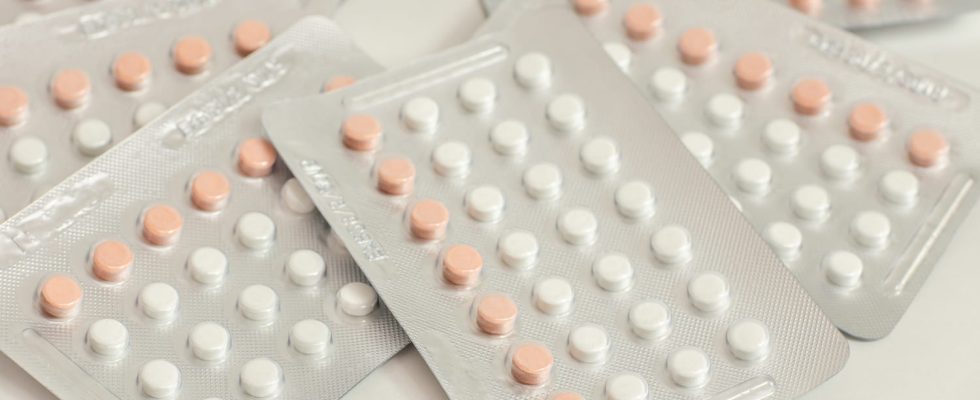There are two main families of pills: estrogen-progestin and microprogestin. And four generations since the first marketing in 1960. Each pill has its mode of action, its side effects and its contraindications.
The estrogen-progestin pill
Estrogen-progestin pills are called “combined” because they are composed of two hormones: one estrogen and a progestin. They block ovulation and modify the endometrium to prevent implantation. They also impact the cervical mucus by making it thicker and therefore impermeable to sperm. “The contraindications of estrogen-progestin pills are extremely numerous and most women call us back after prescribing this type of pill as the list of side effects and contraindication is important”, reports Dr Philippe Mironneau, gynecologist and obstetrician in Dijon. These pills are contraindicated for women suffering from breast or uterine cancer or history of venous or arterial thrombosis, coronary insufficiency or hepatic failure recent or severe. THE smoking is one of the vascular risk factors associated with the pill. They are also not recommended for women suffering from liver diseases and unstabilized cardiovascular problems. “The oldest are ADEPAL® and MINIDRIL® and TRINORDIOL®, but depending on each generation there are around twenty active ingredients now available”, lists Dr. Mironneau.
The microprogestin pill
Unlike others, microprogestin pills only containa single hormone. The latter is present in very small quantities. They may contain desogestrel or levonorgestrel. In the first case, ovulation is suppressed and the women no longer have periods. In the second case, the sperm can no longer pass because the entrance to the cervix is thickened. “They also act by causing a atrophy of the uterine lining, which regularly explains the absence of periods, but also sometimes more serious spotting. These pills have no particular contraindication and can be given to all women., specifies the gynecologist.
What are the different generations of pills?
The different generations of pills depend on the hormone used. There are several generations of pills, they are marketed since 1960.
► First generation : Those of the first generation had a high dose of estrogen. Today there is only TRIELLA®.
► Second generation : The 2nd generation pills were marketed in the 70s and 80s. “These pills contain progestins (norgestrel, levonorgestrel). The change in composition has made it possible to reduce some of the side effects linked to 1st generation pills”, details Dr Philippe Mironneau. Among them: Leeloo®, Optidril®, Minidril®, Optilova®.
► Third generation : The 3rd generation pills combine three new synthetic derivatives of progesterone, desogestrel, gestodene and norgestimate. Please note, they are associated with a higher risk of thromboembolic accident than second generation pills. Among them: Cycleane®, Vamoline®, Optinesse®, Harmonet®, Cilest®.
► Fourth generation : The 4th generation pills, the most recent, contain a new progestin, drospirenone. Among them: Jasmine®, Rimendia®, Belanette®.
Which pill after childbirth?
For 2 months after giving birth, it is strongly advised against prescribing an estrogen-progestin pill. Indeed, it is associated with an increased risk of thromboembolism. It is therefore recommended to favor contraception with a microprogestin pill. Three months after delivery, the gynegologist or midwife may prescribe an estrogen-progestin pill or another contraceptive such as the implant or the patch.
Generic pills
Today, many 2nd or 3rd generation pills exist in generic pill form. The originator molecule and the generic being identical, there was no contraindication particular.
Continuous pills
While some women take a seven-day break from taking the pill, others do not stop it and take it continuously. In this case, they no longer have rules and the risk of forgetting is less significant. Microprogestogen pills and estrogen-progestogen pills allow continuous taking. “It is not dangerous to chain packs of pills to avoid having your period, the problem is that this sequence must be episodic and is often the case with athletes. This attitude allows you not to be bothered by your periods during the holidays, but repeated over the years, continuous sequential pill taking unfortunately ends up also cause mucosal atrophy which regularly causes almost permanent spootings, This is not dangerous but is not necessarily a good solution. specifies Dr. Mironneau.
The morning after pill
The morning after pill allows you to block ovulation if sexual intercourse took place before ovulation. If it occurs later, it prevents the egg from settling on the wall of the uterus. There are currently two morning after pills: NORLEVO® and ELLAONE®. “In one case there are two tablets to take in the other case one tablet to take, it is high dose progestins. Obviously this must remain a exceptional contraception and should not be used as a condom during each intercourse because they are still high doses of progestins which can have hepatic or venous repercussions. recommends the specialist.
Thanks to Dr Philippe Mironneau, gynecologist and obstetrician in Dijon.
